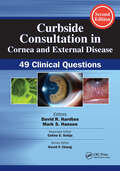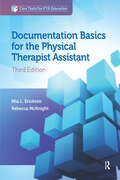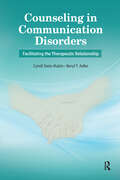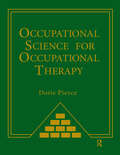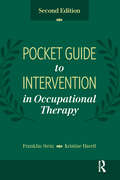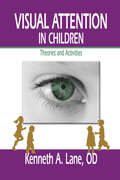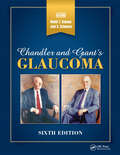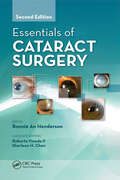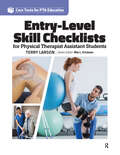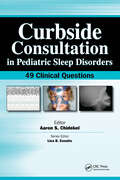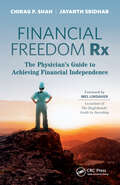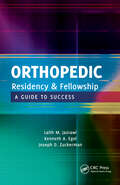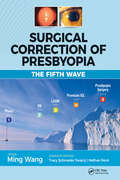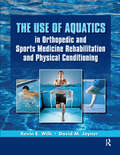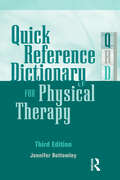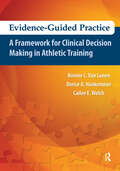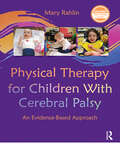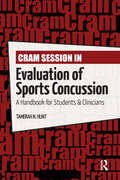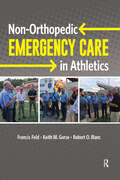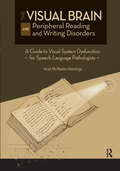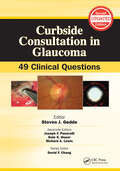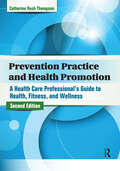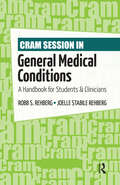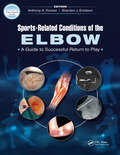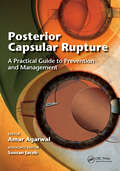- Table View
- List View
Curbside Consultation in Cornea and External Disease: 49 Clinical Questions (Curbside Consultation in Ophthalmology)
by Mark Hansen David R. Hardten Celine SatijaCurbside Consultation in Cornea and External Disease, Second Edition contains new questions and brief, practical, evidence-based answers to the most frequently asked questions that are posed during a “curbside consultation” between clinicians. Dr. David R. Hardten and associate editors Drs. Mark S. Hansen and Celine Satija have designed this unique reference in which cornea and external disease specialists offer expert advice, preferences, and opinions on tough clinical questions commonly encountered by corneal specialists, ophthalmologists, or residents. The unique Q&A format provides quick access to current information with the simplicity of a conversation between two colleagues. Numerous images, diagrams, and references are included to enhance the text and illustrate clinical diagnoses and treatment plans. Some of the questions that are answered inside the Second Edition include: I have a patient with Fuchs' Endothelial Dystrophy. Is there anything new to improve her vision? What should I do with a young patient with mild keratoconus? How can I help a 47-year-old female who uses artificial tears 6 times daily and continues to complain of dry eyes? A patient presents with corneal ulcer. What work-up and treatment would you recommend? How do I manage a patient that rubbed their eye just after LASIK? What could go wrong? What can I offer a patient that sustained eye trauma and loss of iris tissue? I have a patient with poor vision after DMEK. What went wrong and how do I get better vision for them? Curbside Consultation in Cornea and External Disease: 49 Clinical Questions, Second Edition provides information basic enough for residents while also incorporating expert pearls that even high-volume ophthalmologists will appreciate. Cornea specialists, general ophthalmologists, and residents alike will enjoy the user-friendly and casual format and the expert advice contained within.
Documentation Basics for the Physical Therapist Assistant (Core Texts for PTA Education)
by Mia Erickson Rebecca McKnightComplete and accurate documentation is one of the most important skills for a physical therapist assistant to develop and use effectively. The new Third Edition of Documentation Basics for the Physical Therapist Assistant continues the path of teaching the student and clinician documentation from A to Z. Mia Erickson and Rebecca McKnight have updated this Third Edition to reflect changes in the ever-evolving profession. Newly addressed are the changes in documentation requirements for major payers, changes in the disablement models used, and the increasingly common use of electronic documentation in the physical therapy profession. Features inside the Third Edition: Readers are encouraged to think about disablement and disablement concepts when writing notes How to document impairments in body structure and function but more importantly activity limitations and participation restriction Descriptions of the differences in documentation methods using a computer vs paper chart Evidence tied to benefits and challenges of computerized documentation Documenting the rationale for treatment and the unique skills of the physical therapist assistant in patient management New inside the Third Edition: Incorporation of the International Classification of Functioning, Disability, and Health disablement model Chapter on electronic documentation Screenshot examples of the popular WebPT® electronic medical record platform Updated chapters on reimbursement and legal issues Additional examples for student practice included in each chapter Included with the text are online supplemental materials for faculty use in the classroom. Documentation Basics for the Physical Therapist Assistant, Third Edition is the perfect guide for all physical therapist assistant students and clinicians who want to update and refine their knowledge and skills in documentation.
Counseling in Communication Disorders: Facilitating the Therapeutic Relationship
by Cyndi Stein-Rubin Beryl AdlerIncorporating a counseling paradigm has been shown to increase motivation, deepen learning, and sustain progress for clients and families. Counseling in Communication Disorders: Facilitating the Therapeutic Relationship by Cyndi Stein-Rubin and Beryl T. Adler, is an engaging textbook, written in a genuine and lively tone, so that the reader may easily relate to the material. The text provides a practical vehicle for speech-language pathology students, clinicians, clinical supervisors, and instructors to get to know themselves better and to integrate basic counseling attitudes and tools into their diagnostic and therapeutic programs. Inside Counseling in Communication Disorders, Stein-Rubin and Adler describe the importance of addressing a client’s communication challenges by working with the whole person, as a human being, not as a communication disorder. By approaching clients with a counseling attitude that encourages the client’s full participation in the treatment process, we then work together in partnership and as a powerful team. The content, techniques, and exercises within Counseling in Communication Disorders are rooted in evidence-based practice from a variety of psychological, counseling, and coaching approaches, such as Humanistic Counseling, Listening and Language, Narrative Therapy, The Cognitive Behavioral Model (CBT), Solution-Focused Brief Therapy (SFBT), Positive Psychology, Neurolinguistic Programming (NLP), and Mindfulness training.Counseling in Communication Disorders also includes reflective questions, exercises, and suggestions to reinforce important concepts. To bring the content to life, real-life and clinical scenarios are interspersed throughout the text.It is well understood that speech-language pathology and audiology clinicians must understand deep listening and how to choose words that will have a positive impact on their client and families, but often overlooked is the personal development of the clinicians themselves. Counseling in Communication Disorders is a comprehensive guide on how to provide the necessary support and encouragement to clients and build self-esteem, while a major focus is the need for the clinicians to work on self before working on other. Counseling in Communication Disorders: Facilitating the Therapeutic Relationship is the first textbook of its kind to comprehensively cover both sides of the therapeutic relationship. Students and clinicians alike will appreciate this unique approach that addresses not only the counseling attitude that is vital to the growth and progress of clients, but also the self-awareness that guides the personal development of the clinician.Included with the text are online supplemental materials for faculty use in the classroom.
Occupational Science for Occupational Therapy
by Doris PierceOccupational Science for Occupational Therapyarticulates how occupational science research produces unique insights into occupation and increases the effectiveness of occupational therapy interventions. This text illustrates the four key types of knowledge now being researched in occupational science: descriptive, relational, predictive, and prescriptive. This text also offers a comprehensive review of occupational science’s history of emergence from the needs and interests of occupational therapy, conflicting origins and intents, and ongoing development as a discipline within academia. In Occupational Science for Occupational Therapy, Dr. Doris Pierce and an outstanding group of occupational scientists explain how their discoveries build the science and support practice. A rich variety of methods and perspectives mark the work of these career scientists as they respond to the knowledge base needs of occupational therapy. This fully evidence-based text also brings the research experience alive for occupational therapy students, describing the passions, challenges, and choices that are the reality of research as an occupation. All research chapters discuss how findings build both science and practice, including learning supports in which students can try out research activities, explore assessment, or develop interventions. Most importantly, Occupational Science for Occupational Therapyprovides new and experienced practitioners a thorough exploration of the latest research in occupation-based practice.Occupational Science for Occupational Therapy synthesizes key works by occupational scientists, including a foreword by Dr. Elizabeth Yerxa, founder of the science. Occupational therapy and occupational science students, practitioners, and faculty will especially appreciate this book’s comprehensive coverage of work by current leaders of research on occupation-based practice.
Pocket Guide to Intervention in Occupational Therapy
by Kristine Haertl Franklin SteinPocket Guide to Intervention in Occupational Therapy, Second Edition builds upon the strengths of the first edition as a useful quick reference of occupational therapy terms and interventions regarding specific diagnoses and conditions. Occupational therapy is an evidence-based health care profession that uses scientifically based research to justify clinical practice. Interventions in hospitals, clinics, and community and school settings continue to evolve based on scientific evidence. These interventions are intended to prevent injury and maintain or improve client function. Pocket Guide to Intervention in Occupational Therapy, Second Edition by Dr. Franklin Stein and Dr. Kristine Haertl is organized around the major conditions that occupational therapists encounter in their everyday practice. These include physical, psychosocial, cognitive, geriatric, and pediatric diagnoses. Intervention guidelines are outlined for the major disabilities. In addition, there are brief descriptions of the intervention techniques that therapists use and definitions of terms that are relevant to interventions. Intervention techniques encompass the following: Non-medical techniques such as client health education or counseling Instruction in activities of daily living, modifying of environment such as in ergonomics Teaching and demonstrating arts and crafts as therapeutic activities Providing sensory stimulating activities especially for children The appendices include an outline of essential skills for occupational therapists, general developmental guidelines, an overview of muscles and movements, orthotic devices, tables of muscles, average range of motion measurements, prime movers for upper and selected lower extremity motions, and substitutions for muscle contractions.Pocket Guide to Intervention in Occupational Therapy, Second Edition is based on the latest scientific evidence garnered from recent research studies, meta-analyses, scoping reviews, occupational therapy textbooks and their own wide experiences as a clinician, professor and researcher.
Visual Attention in Children: Theories and Activities
by Kenneth LaneIn typical child development, attention controls many aspects of learning, including memory, motor control, and problem solving. Attention organizes the constant influx of information that needs to be absorbed by children. Inside Visual Attention in Children: Theories and Activities, Dr. Kenneth A. Lane describes the positive aspects of attention that are needed for children to be successful in the classroom, such as concentration and vigilance, as opposed to negative aspects that can lead to failure, such as distractibility and confusion. This book is divided into two parts. The first eight chapters of the book explain attention and its relationship to vision and visual stimuli. The core topics discussed here include Autism, ADHD, Dyslexia, Executive Function, and Memory. The second half outlines a Vision Therapy program and consists of activities for improving visual attention in children. Over 100 activities are explained and illustrated.Visual Attention in Children: Theories and Activities is anchored on current theories in five areas of attention that shape child development.Theories Described Include:• Focused Attention – The ability to respond discreetly to visual, auditory, and tactile stimuli• Selective Attention – The ability to maintain behavioral or cognitive abilities in the face of distracting or competing stimuli• Shifting Attention – The ability to rapidly shift attention from one object to another• Sustained Attention – The ability to maintain a consistent behavioral response during a continuous or repetitive activity• Divided Attention –The ability to engage in more than one attention-focused task at one time.Visual Attention in Children: Theories and Activities is the perfect tool for occupational therapy students and clinicians as well as other professionals specializing in child development and learning who are looking to enhance their understanding of this topic and who need unique ideas and activities to add to their visual therapy training programs.
Chandler and Grant's Glaucoma
by Malik Kahook Joel S. SchumanChandler and Grant’s Glaucoma—one of the field’s seminal texts on the medical practice and surgical management of glaucoma, now in its Sixth Edition—includes the latest updates in an area that is currently experiencing a surge of innovation. Edited by Drs. Malik Y. Kahook and Joel S. Schuman and with writings from the late Dr. David L. Epstein and more than 80 contributors, Chandler and Grant’s Glaucoma, Sixth Edition brings together the experience of world-class glaucoma experts who belong to a long line of surgeons trained using the teachings of the original authors of this classic work. Each chapter has been meticulously edited and updated from the previous edition, while maintaining the well-established historical teachings of Drs. Paul A. Chandler and W. Morton Grant. New chapters on medical therapy as well as thorough updates on novel and minimally invasive approaches for the surgical management of glaucoma have been added. New topics and features in the Sixth Edition include: Advances in imaging of the optic nerve and retina Rho-associated protein kinase inhibitors Glaucoma and cerebrospinal fluid pressure The FDA’s role in the development of new diagnostic and surgical devices for patients with glaucoma Chandler and Grant’s Glaucoma has been the most relevant and invaluable reference on glaucoma for generations of ophthalmologists. This updated Sixth Edition builds on the teachings of previous editions, making the Sixth Edition as relevant in the 21st century as when the first lectures were presented by Drs. Chandler and Grant more than 55 years ago.
Essentials of Cataract Surgery
by Bonnie HendersonThe straightforward, concise, and easy-to-read reference manual which is equivalent to having the best instructor offering guidance on what to do next and how to avoid potential complications is now available in an updated Second Edition.Essentials of Cataract Surgery, Second Edition comprehensively details every step of phacoemulsification cataract extraction surgery, from preoperative evaluation to intraoperative instruction to postoperative care. The basic elements of cataract surgery are presented in a clear and easy-to-read format.Dr. Bonnie An Henderson brings together advice and teaching techniques from the Harvard Intensive Cataract Surgical Training Conference at the Massachusetts Eye and Ear Infirmary. The book provides both beginning and practicing surgeons with personal tips and expert advice from leading cataract mentors of top US ophthalmology residency programs. Inside Essentials of Cataract Surgery, Second Edition are detailed chapters covering fluidics, IOL calculations and design, capsular complications and management, and the latest phaco technology, including femtosecond cataract surgery. Each chapter contains a summary box, highlighting the key points of each topic discussed. Additionally, the included images, diagrams, photographs, and tables enhance understanding of specific topics.With detailed information and expert pearls in a user-friendly format, Essentials of Cataract Surgery, Second Edition is perfect for residents, fellows, medical students, and practicing ophthalmologists looking to improve their surgical techniques.
Entry Level Skill Checklists for Physical Therapist Assistant Students (Core Texts for PTA Education)
by Terry LarsonA new resource to support and track student development across PTA programs, Entry-Level Skill Checklists for Physical Therapist Assistant Studentsis a visually appealing lab manual that includes entry-level PTA skills in a user-friendly, step-by-step checklist format.Written by seasoned PT and PTA instructor Dr. Terry Larson, Entry-Level Skill Checklists for Physical Therapist Assistant Studentscombines skill and evaluation measures into checklists so instructors may track their students’ progress with ease. The book is meant to follow students throughout their programs of study—from their first lab course to submission at the end of their program. Created to reflect the Commission on Accreditation in Physical Therapy Education guidelines, Entry-Level Skill Checklists for Physical Therapist Assistant Studentsis the latest entry into SLACK Books’ Core Texts for PTA Education series.What’s included in Entry-Level Skill Checklists for Physical Therapist Assistant Students: Sections on data collection and intervention Checklists following each skill stage to record and evaluate progress Checkboxes for peer evaluation and instructor assessment Comment areas for instructors to provide feedback on development of student abilities Across courses and programs, Entry-Level Skill Checklists for Physical Therapist Assistant Students will help students facilitate self-evaluation and professors gauge and document student progress in any PTA program.
Curbside Consultation in Pediatric Sleep Disorders: 49 Clinical Questions (Curbside Consultation in Pediatrics)
by Aaron ChidekelAre you looking for concise, practical answers to those questions that are often left unanswered by traditional pediatric sleep disorder references? Are you seeking brief, evidence-based advice for complicated cases or controversial decisions? Curbside Consultation in Pediatric Sleep Disorders: 49 Clinical Questions provides quick answers to the tricky questions most commonly posed during a “curbside consultation” between pediatricians. Dr. Aaron Chidekel has designed this unique reference which offers expert advice, preferences, and opinions on tough clinical questions commonly associated with pediatric sleep disorders. The unique Q&A format provides quick access to current information related to pediatric sleep disorders with the simplicity of a conversation between two colleagues. Numerous images, diagrams, and references allow readers to browse large amounts of information in an expedited fashion.Some of the questions that are answered: Why do we sleep and what is happening when children sleep? How does sleep change from infancy to adulthood? What are the latest recommendations for safe infant sleep and the prevention of SIDS? What are some pearls or strategies to manage or even better, to prevent behavioral sleep disorders in young children? What is obstructive sleep apnea syndrome? What is narcolepsy and do children actually develop this condition? Which of my patients should have a polysomnogram? Curbside Consultation in Pediatric Sleep Disorders: 49 Clinical Questions provides information basic enough for residents while also incorporating expert advice that even high-volume pediatricians will appreciate. Pediatricians, family practitioners, and pediatric residents will benefit from the user-friendly, casual format and the expert advice contained within.
Financial Freedom Rx: The Physician’s Guide to Achieving Financial Independence
by Chirag Shah Jayanth Sridhar"The best physician-specific general financial book published in 2021." —James M. Dahle, MD, author of The White Coat InvestorA step-by-step guidebook for doctors and other medical professionals about growing and preserving wealth, Financial Freedom Rx: The Physician’s Guide to Achieving Financial Independence gives physicians all the tools necessary to manage their own finances and includes a foreword by Mel Lindauer, co-author of The Bogleheads' Guide to Investing. Medical professionals, especially doctors, spend many years in training as they accumulate debt and delay their earnings. This book presents a time-tested formula that students and established professionals can follow at any stage during their careers to achieve fiscal peace of mind. Students will learn how to budget and adopt disciplined financial practices. Residents and other trainees will learn how to defend against calamity with various insurances and how to manage debt. Junior professionals will acquire the skills needed to invest and grow their portfolios, while senior professionals will better understand the essentials of estate planning and retirement. Drs. Chirag P. Shah and Jayanth Sridhar wrote this inspiring text to guide physicians where to put their next dollar. This is particularly important during the financial uncertainties brought on by COVID-19 and insurance cuts. Financial Freedom Rx sets forth principles that will pilot medical professionals toward financial independence. Chapters include useful advice on topics such as: Financial planning Investing and asset allocation Jobs and contracts Taxes and insurance Student loans and debt Retirement savings and distributions Financial Freedom Rx: The Physician’s Guide to Achieving Financial Independence serves as a timeless blueprint for financial planning that medical professionals will follow throughout their careers, and as a reference that readers will revisit again and again as they progress through the various stages of life.
Orthopedic Residency and Fellowship: A Guide to Success
by Kenneth Egol Joseph Zuckerman Laith JazrawiOrthopedic surgery remains one of the most competitive subspecialties in medicine. This “how- to” guide describes how medical students can achieve their goal of being accepted into an orthopedic residency program and how to thrive once there.What will you learn from Orthopedic Residency and Fellowship: A Guide to Success?• How medical students can achieve their goal of being accepted into an orthopedic residency program• How to succeed during and after your residency• Tips and pearls to maximize your experience• Budgeting your time• Peer interaction• Job placement• How to read a contract• How to decide between academic or private practice• Asset protection • Making the right financial decisionOrthopedic Residency and Fellowship: A Guide to Success by Drs. Laith M. Jazrawi, Kenneth A. Egol and Joseph D. Zuckerman is the only book on the market that solely focuses on getting into an orthopedic residency or fellowship training program, excelling once you are there, and maximizing and obtaining the right practice opportunity for you. Providing easy-to-read chapters and quick reference materials, this book is a must-read for anyone interested in the field of musculoskeletal care.
Surgical Correction of Presbyopia: The Fifth Wave
by Ming WangUntil recently, surgical correction of presbyopia was considered the “last frontier” in ophthalmology, but today there are a wide variety of treatments available. This Fifth Wave of ophthalmology opens up a whole world of surgical solutions for presbyopes who would otherwise have no recourse, and Surgical Correction of Presbyopia: The Fifth Wave is designed as a complete guide to the wide range of surgical solutions available. Dr. Ming Wang is joined by Associate Editors Drs. Tracy Schroeder Swartz and Nathan Rock and their all-star team of expert contributors to compile the first comprehensive review of all the state-of-the-art surgical treatments for presbyopia. This includes a history of refractive and lens surgery, a review of presbyopia and its medical management, as well as in-depth sections on not only those surgical treatments that are currently available but also those under active clinical investigation. Inside Surgical Correction of Presbyopiais a detailed presentation on corneal solutions, including laser treatments and corneal inlays; lenticular solutions, including intraocular lenses; and scleral solutions, such as scleral implants and ablation. Each procedure features a discussion on the indications, benefits, results and risks of the procedure with close attention to clinical applications. Also included are chapters on complex cases, which focus on improving outcomes both with patient and surgical modality selection and postoperative management.Chapters include: Excimer and Femtosecond LASER for Treatment of Presbyopia Shape-Changing Inlays Multifocal Intraocular Lenses Extended Depth of Focus Intraocular Lenses Laser Scleral Microablation Procedure Marketing Surgical Treatment for Presbyopia The Future of Presbyopia Treatment Presbyopia is the most common refractive condition and more patients and providers are actively seeking surgical solutions. With Surgical Correction of Presbyopia: The Fifth Wave, anyone from ophthalmology technicians and opticians to practicing ophthalmologists and optometrists will confidently understand and be prepared to tackle this “last frontier” of ophthalmology.
The Use of Aquatics in Orthopedics and Sports Medicine Rehabilitation and Physical Conditioning
by David Joyner Kevin WilkThe Use of Aquatics in Orthopedic and Sports Medicine Rehabilitation and Physical Conditioning is a definitive and scientifically based text on the use and application of aquatic methodologies in both rehabilitation and physical conditioning appropriate for the general population to the elite athlete.The Use of Aquatics in Orthopedic and Sports Medicine Rehabilitation and Physical Conditioning represents a new generation of rehabilitation that is informative enough to be injury and sports specific. Dr. Kevin E. Wilk and Dr. David M. Joyner, along with noted domestic and international leaders in the field, explore the aquatic techniques and principles detailed in the work, while presenting this scientifically based material in an understandable and user-friendly format. Ten chapters take the reader from the history of aquatic rehabilitation and progress to discuss all parameters of aquatic rehabilitation.Some chapter topics include:• History, theory, and applications of aquatic therapy• Pool selection, facility design, and engineering considerations• Rehabilitation for the upper and lower extremities and spine• Sports-specific training• Research evidence for the benefits of aquatic exercise• Appendices, including 4 specific protocols for various lesions and disordersThe Use of Aquatics in Orthopedic and Sports Medicine Rehabilitation and Physical Conditioning represents a new era in the use and development of aquatic therapy in sports medicine rehabilitation and is perfect for physical therapists, athletic trainers, strength and conditioning coaches, personal trainers, and sports medicine professionals alike.
Quick Reference Dictionary for Physical Therapy
by Jennifer BottomleyQuick Reference Dictionary for Physical Therapy has been revised and updated into a Third Edition to include the latest information in the field of physical therapy. This reference book, designed specifically for the physical therapy and physical therapist assistant student and practitioner, provides a magnitude of terms, definitions, guidelines, and references essential to the field. This Third Edition provides quick access to over 3400 words and their definitions that are encountered on a day-to-day basis (400 more than the previous edition). There are also 41 appendices in this user-friendly, pocket-sized reference where you can find information such as lists of general acronyms and abbreviations for words commonly used in physical therapy/rehabilitation; commonly used acronyms for evaluative tests and measures; and definitions of impairment, disability, and handicap as established and accepted by the World Health Organization. What is new inside the Third Edition:• More than 100 new abbreviations and acronyms• Updated Code of Ethics for the Physical Therapist• A new Drug Prescribing and Elimination Abbreviations appendix• Updates to suggested readingsQuick Reference Dictionary for Physical Therapy, Third Edition is the perfect, pocket size, affordable companion for school, clinical affiliations, and physical therapy practice.
Evidence-Guided Practice: A Framework for Clinical Decision Making in Athletic Training
by Bonnie Van Lunen Dorice Hankemeier Cailee WelchAthletic trainers must have a foundation in the concepts of evidence-based practice to deliver patient care in an effective way. It is critical that students and clinicians formulate clinical plans that will be effective for individual patients. With that goal in mind, Evidence-Guided Practice: A Framework for Clinical Decision Making in Athletic Training teaches the athletic trainer that evidence-based practice concepts must be incorporated into daily clinical practice. Written in a conversational tone, Drs. Bonnie Van Lunen, Dorice Hankemeier, and Cailee Welch provide a practical and concise resource for athletic trainers to use when interpreting what the available evidence means for them and how it can be effectively applied in daily patient care. The competencies within athletic training and other health care professions were considered when each chapter was constructed. Special care was taken to include examples that are specific to athletic training and instructional applications for educators.What Is Inside: Types of research design Foundations of research and statistics Introduction to critical appraisal Concepts of validity Diagnostic accuracy Disablement models Patient-oriented outcome assessments Health care informatics The first of its kind, Evidence-Guided Practice: A Framework for Clinical Decision Making in Athletic Training is the only resource athletic training students, clinicians, or other health care professionals will need to properly put evidence-based concepts into practice.
Physical Therapy for Children With Cerebral Palsy: An Evidence-Based Approach
by Mary RahlinCerebral palsy is the most common movement disorder encountered in pediatric physical therapy practice. Physical Therapy for Children With Cerebral Palsy: An Evidence-Based Approach is a unique, comprehensive reference that focuses on physical therapy management of children with cerebral palsy through the analysis and synthesis of published research, and it offers evidence-based teaching and learning opportunities to a wide reading audience.Inside, Dr. Mary Rahlin examines the current approach to the diagnosis and classification of cerebral palsy and explores the research evidence related to prognosis; medical management; and physical therapy examination, evaluation, and intervention for children with this condition. Physical Therapy for Children With Cerebral Palsy analyzes cerebral palsy as a lifespan condition and utilizes the framework of International Classification of Functioning, Disability and Health (ICF).Sections include: Typical and atypical development of movement and postural control Cerebral palsy as a development disorder Medical management of alterations of body structures and functions by body systems Physical therapy management, including theoretical foundation, research evidence, and practice Normal and abnormal gait patterns and current evidence for orthotic management and assistive technology Transition to adult life Unique topics discussed: Variability, complexity, and adaptability in motor development The interdisciplinary team and effective interprofessional collaboration Assessment and management of therapy-related behavior Complementary and alternative interventions Segmental kinematic approach to orthotic management via ankle-foot-orthosis/footwear combination Other unique features include “Questions to Ponder” and “Suggested Questions for Future Research” at the end of each chapter. These are intended to generate healthy professional debate on a variety of topics, both in the classroom and in the clinic, and challenge the readers to plan new studies in search for evidence that will continue moving the pediatric physical therapy practice forward. Bonus! Also included with Physical Therapy for Children With Cerebral Palsy is online access to video clips that accompany the text and highlight typical and atypical development, use of assistive technology, life span issues, and transition to adulthood.Physical Therapy for Children With Cerebral Palsy: An Evidence-Based Approach is intended for physical therapy students, educators, residents, and experienced clinicians, including physical therapists, other members of the interdisciplinary team, and researchers working with children with cerebral palsy.
Cram Session in Evaluation of Sports Concussion: A Handbook for Students & Clinicians
by Tamerah HuntWhen you need a fundamental and clinical understanding of sports concussions, supplemented by current research and management techniques, look to Cram Session in Evaluation of Sports Concussion: A Handbook for Students & Clinicians for quick and at-your-fingertips facts.Cram Session in Evaluation of Sports Concussion: A Handbook for Students & Clinicians by Dr. Tamerah N. Hunt is a succinct and descriptive quick reference that provides the health care professional with a simple step-by-step approach to various sports concussion assessment and management techniques. Cram Session in Evaluation of Sports Concussion: A Handbook for Students & Clinicians is designed to bridge the gap between research and clinical practice to improve assessment and management of sports-related concussion and return-to-play decisions. What is in your “Cram Session”: • Concept maps• Red flags for differential diagnoses• Return to participation guidelines• Detailed algorithms for evaluation, testing, and working with other health care professionals• Model protocols and management strategies that can be implemented with minimal resources and support staffCram Session in Evaluation of Sports Concussion: A Handbook for Students & Clinicians is an informative, well-organized handbook for all students and clinicians in athletic training, physical therapy, and allied health professionals who evaluate and manage concussions.
Non-orthopedic Emergency Care in Athletics
by Francis Feld Keith Gorse Robert BlancNon-Orthopedic Emergency Care in Athletics is a textbook that will help instruct athletic training students, certified athletic trainers, and other health care providers about the emergency medical situations they can potentially face throughout their careers. Francis Feld, Keith M. Gorse, and Robert O. Blanc, along with their contributors, have covered the most crucial types of serious medical emergencies that may be encountered in sports. Also included is material for each of the Domains listed in the NATA Board of Certification (BOC) and the Education Competencies and Proficiencies listed in the 2020 CAATE Standards. What is covered inside Non-Orthopedic Emergency Care in Athletics: Design and Implementation of Emergency Action Plans & Standard Operating Procedures Mass Casualty Substance Abuse Cardiac and Respiratory Care Endocrine Emergencies Environmental Conditions Shock Seizures Abdominal Emergencies Psychiatric Issues Bleeding Disorders Non-Orthopedic Emergency Care in Athletics is an ideal text for certified athletic trainers, athletic training students, and other health care providers focusing on the skills, knowledge, practice, and preparation needed to handle real athletic emergency medical situations.
The Visual Brain and Peripheral Reading and Writing Disorders: A Guide to Visual System Dysfunction for Speech-Language Pathologists
by Heidi HeeringaThe Visual Brain and Peripheral Reading and Writing Disorders: A Guide to Visual System Dysfunction for Speech-Language Pathologists familiarizes the reader with the complex workings of the human visual system, the motor and sensory components of normal vision as they relate to the recognition of letters and words, and to the acquisition and rehabilitation of reading and writing.This text brings together findings from the neuropsychological, neurooptometric, neurolinguistic, occupational therapy, and speech-language pathology literature on acquired visual system impairment from the past 20+ years, and the ways visual system dysfunction impacts reading, writing, and cognition.Chapters Include: Review of structural elements of the eye, the cortical and subcortical structures of the visual brain, and the motor and sensory components of normal vision The distinct functions of the three primary visual pathways (central, peripheral and retinotectal) and how they relate to reading and writing Review of five formal tests of reading and writing that are designed or may be adapted to assess peripheral reading and writing disorders And much more! A few of the features inside: Figures illustrating the various components of the visual brain that are engaged when we read and write Information on visual system deficits in left hemisphere lesions with and without aphasia Detailed descriptions of peripheral reading disorders and associated error patterns Diagnostic criteria for three different types of neglect (viewer-centered, stimulus-centered, object-centered) Description of treatment materials and methods suited to clients with acquired dyslexia due to visual system dysfunction The Visual Brain and Peripheral Reading and Writing Disorders explains the heterogenous nature of peripheral reading and writing disorders, describes the association between visual motor and sensory dysfunction and the acquired dyslexias, and provides the speech-language pathologist with specific guidelines regarding the assessment and treatment of reading and writing disorders associated with visual system dysfunction.
Curbside Consultation in Glaucoma: 49 Clinical Questions (Curbside Consultation in Ophthalmology)
by Steven GeddeCurbside Consultation in Glaucoma: 49 Clinical Questions has been updated into a Second Edition! The Second Edition contains new questions and is completely updated! Curbside Consultation in Glaucoma, Second Edition contains new questions and brief, practical, evidence-based answers to the most frequently asked questions that are posed during a “curbside consultation” between surgical colleagues. Dr. Steven J. Gedde and associate editors Dr. Dale K. Heuer, Dr. Richard A. Lewis, and Dr. Joseph Panarelli have assembled the top glaucoma consultants from the United States and abroad to offer expert advice, preferences, and opinions on tough clinical questions commonly associated with glaucoma in this updated reference. The unique Q&A format provides quick access to current information related to glaucoma in the simplicity of a conversation between two colleagues. Numerous images, diagrams, and references are included to enhance the text and illustrate surgical pearls. Some of the questions that are answered inside theSecond Editioninclude: - What imaging technology is best for diagnosing glaucoma? For detecting progression? - What new methods are available to measure intraocular pressure? Are any devices available for continuous monitoring of intraocular pressure? - Do anti-VEGF agents produce intraocular pressure elevation? - How should I set a target intraocular pressure? - How should I manage a patient who is progressing at low levels of intraocular pressure? - Does cataract extraction produce significant and sustained intraocular pressure reduction? When should I perform a combined procedure versus cataract surgery alone? - What are MIGS? When should I use them?Curbside Consultation in Glaucoma: 49 Clinical Questions, Second Edition provides information basic enough for residents while also incorporating expert pearls that even high-volume glaucoma specialists will appreciate. General practitioners, residents, fellows, and optometrists alike will benefit from the user-friendly, casual format and the expert advice contained within.
Prevention Practice and Health Promotion: A Health Care Professional’s Guide to Health, Fitness, and Wellness
by Catherine Rush ThompsonThe all-encompassing Second Edition of Prevention Practice and Health Promotion: A Health Care Professional’s Guide to Health, Fitness, and Wellness offers foundational knowledge to health care professionals implementing primary, secondary, and tertiary prevention to healthy, at-risk, and disabled populations.Dr. Catherine Thompson along with her contributors, all with diverse backgrounds in physical therapy, rehabilitation, and healthcare, present the interdisciplinary health care perspective of health, fitness, and wellness concepts that are critical for providing preventive care to healthy, impaired, and at-risk populations using the World Health Organization’s International Classification of Functioning, Disability, and Health model as a guideline for assessment and management.Based upon the goals outlined in Healthy People 2020, Prevention Practice and Health Promotion, Second Edition also combines the vision of direct access for health care professionals with the goals of national health care to increase the quality of years of healthy life, as well as to eliminate health disparities between various populations. Recognizing the cost effectiveness of preventive care, health care professionals have an expanded role in health promotion and wellness, complementing evidence-based medical management of acute and chronic conditions.Some topics covered inside Prevention Practice and Health Promotion, Second Edition include an overview of screening across the lifespan; effective interventions to promote health, fitness, and wellness; and options for program development, including marketing and management strategies to address both individual and community needs.Included with the text are online supplemental materials for faculty use in the classroom.Features of the Second Edition:• Use of the American Physical Therapy Association’s Guide to Physical Therapist Practice, Second Edition for health promotion• Screening tools for special populations, including children, pregnant women, older adults, individuals with developmental disabilities, and people with chronic conditions affecting their quality of life• Resources to promote healthy living, including nutrition, stress management, fitness training, and injury preventionPerfect for clinicians, students, allied health professionals, rehabilitation specialists, physical medicine specialists, and recreation therapists, the Second Editionto Prevention Practice and Health Promotion is a valuable resource for everyone in the areas of health, fitness, and wellness.
Cram Session in General Medical Conditions: A Handbook for Students and Clinicians
by Robb Rehberg Joelle RehbergAre you a rehabilitation professional or student in need of a basic understanding of general medical conditions? Supplemented by concise and user-friendly clinical information on the conditions, Cram Session in General Medical Conditions: A Handbook for Students & Clinicians is the perfect resource for quick and “at your fingertips” facts.Cram Session in General Medical Conditions: A Handbook for Students & Clinicians by Dr. Robb S. Rehberg and Dr. Joelle Stabile Rehberg is a succinct and descriptive quick reference that provides the rehabilitation professional with a very basic approach to understanding various general medical conditions. What is in your “Cram Session”:• Breakdown of each medical condition covered• Each condition includes the name of the condition, alternate names, description, causes, clinical presentation, symptoms, diagnosis, and management• Includes over 125 general medical conditions in over 13 categoriesCram Session in General Medical Conditions: A Handbook for Students & Clinicians is an informative, well-organized handbook for all students and clinicians in athletic training, physical therapy, occupational therapy, and orthopedics.
Sports-Related Conditions of the Elbow: A Guide to Successful Return to Play
by Anthony Romeo Brandon EricksonA comprehensive review, Sports-Related Conditions of the Elbow: A Guide to Successful Return to Play is a valuable resource for orthopedic surgeons as well as athletic trainers, therapists, and primary care physicians who regularly deal with athletes. Edited by Drs. Anthony A. Romeo and Brandon J. Erickson, Sports-Related Conditions of the Elbow: A Guide to Successful Return to Play is the most thorough text regarding how to treat athletic elbow conditions. Chapters are broken down by specific conditions, including in-depth assessments of muscle, tendons, ligaments, bone, nerves, and more. With insight given by expert contributors, including several physicians for professional and collegiate teams, the text shares extensive knowledge from these experts for treating conditions of the elbow. Additionally, each chapter includes: Expert pearls and experiences in treating athletes with the mentioned pathologic condition A synopsis on diagnosis as well as treatment algorithms Technique videos that display physical exam maneuvers, how to critically assess various types of diagnostic imaging, and surgical techniques A rehabilitation section focusing on the best-available evidence to allow these athletes to return to sport as efficiently and safely as possible Video website access is included with purchase, providing additional audio-visual support to theories and principles discussed in each chapter by the world’s leading experts.Sports-Related Conditions of the Elbow: A Guide to Successful Return to Play is a must-have text that focuses on best practices in sports medicine and covers a wide range of common and uncommon elbow conditions that athletes of all levels of play may encounter.
Posterior Capsular Rupture: A Practical Guide to Prevention and Management
by Amar AgarwalPosterior Capsular Rupture: A Practical Guide to Prevention and Management addresses a nightmare of every cataract surgeon: a posterior capsular rupture. The book details each aspect of the process, from prevention of a posterior capsular rupture to management and IOL placement. Dr. Amar Agarwal and his contributors, leading international ophthalmic surgeons, discuss the latest techniques in easy-to-understand text and format and include more than 250 high-quality photographs that enhance reader comprehension. Posterior Capsular Rupture: A Practical Guide to Prevention and Management presents a variety of complicated cases and complications such as posterior polar cataracts, IOL scaffold & glued IOL, sutured IOLs, management of dislocated IOLs, and corneal damage & posterior capsule rupture, to name a few.Additionally, a video website accompanies Posterior Capsular Rupture: A Practical Guide to Prevention and Management and allows readers to gain a better understanding of the subject. Practicing ophthalmologists, residents, and post-graduate students alike will benefit from this book’s clear portrayal of this difficult medical issue.
